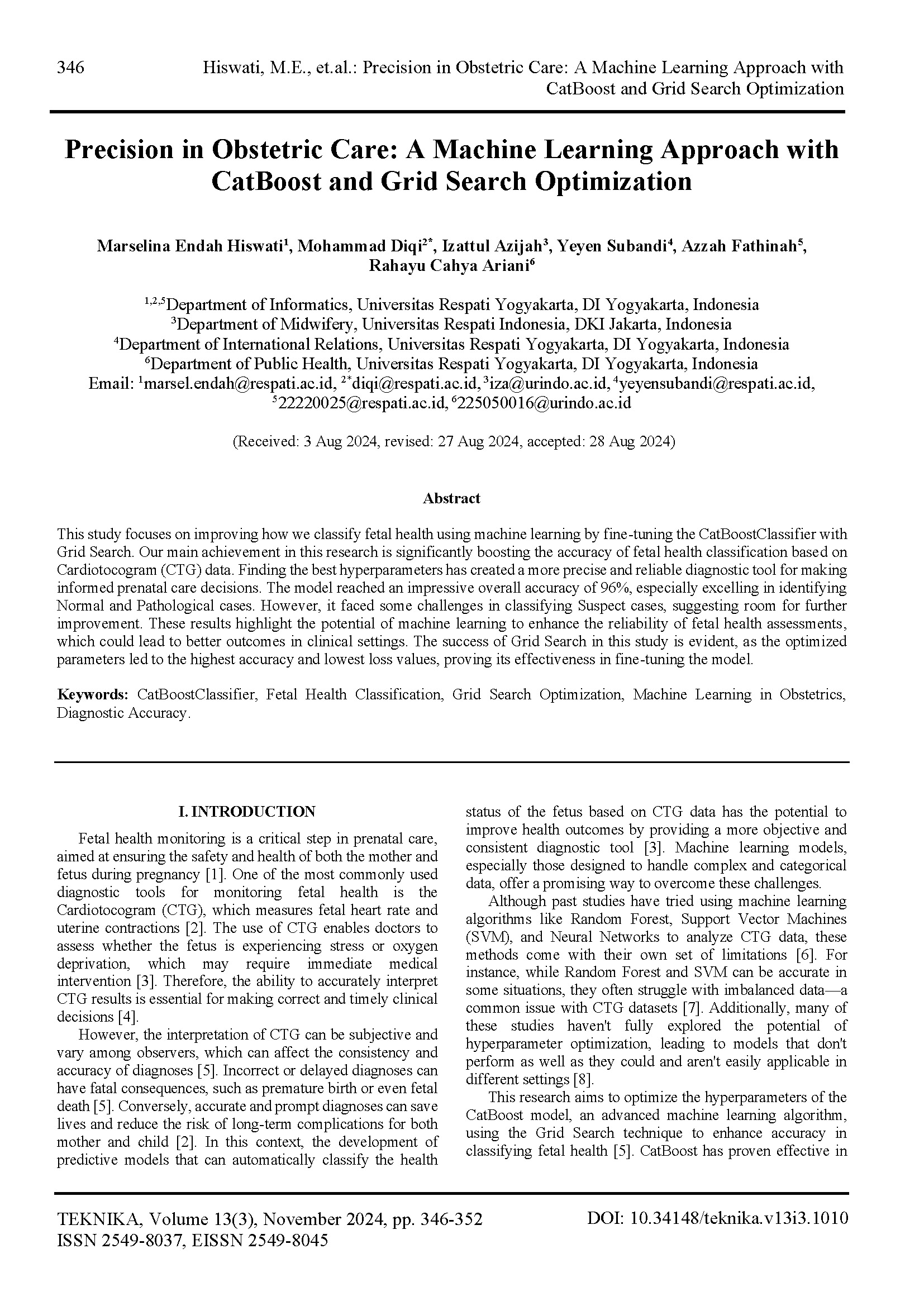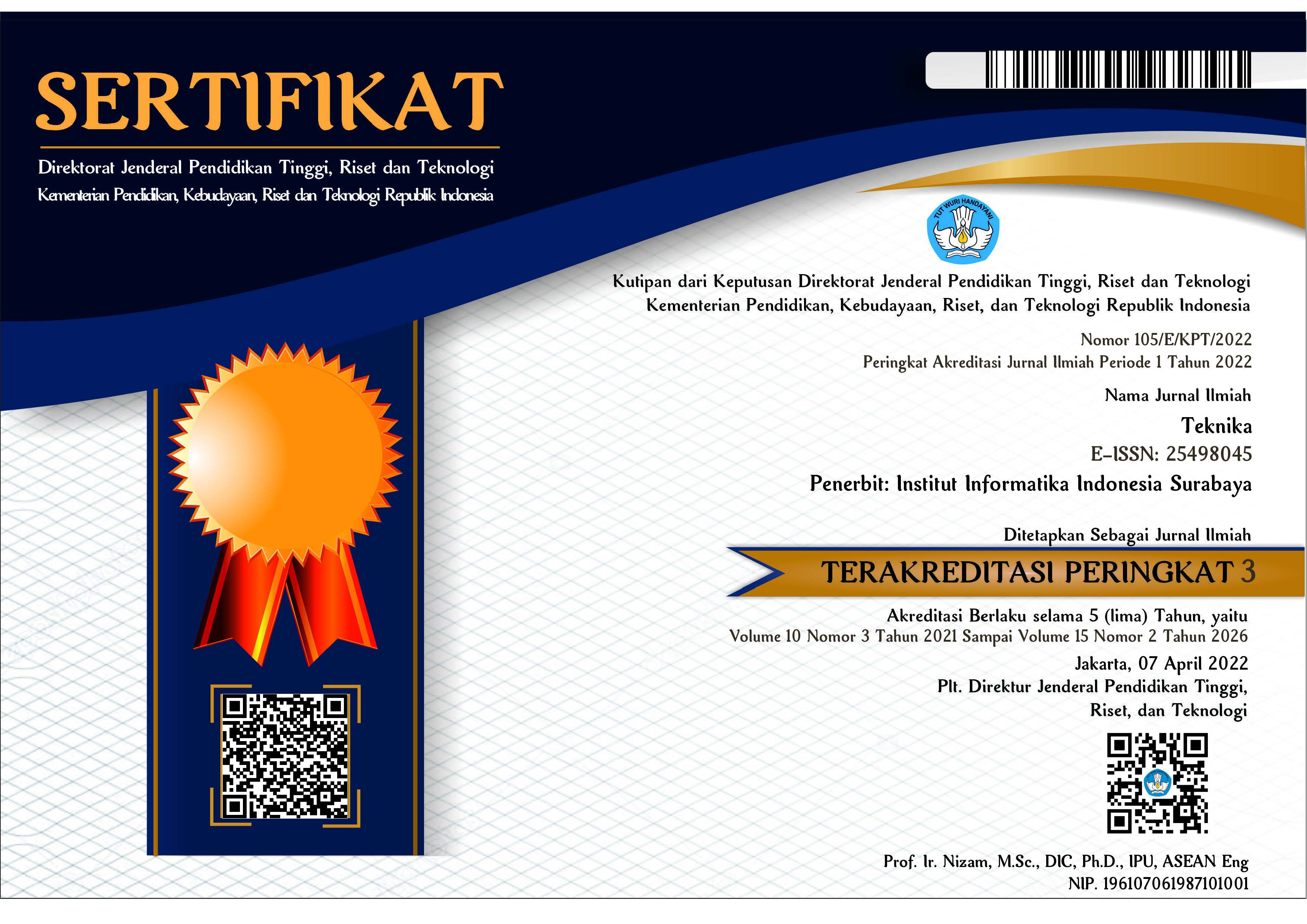Precision in Obstetric Care: A Machine Learning Approach with CatBoost and Grid Search Optimization
DOI:
https://doi.org/10.34148/teknika.v13i3.1010Keywords:
CatBoostClassifier, Fetal Health Classification, Grid Search Optimization, Machine Learning in Obstetrics, Diagnostic AccuracyAbstract
This study focuses on improving how we classify fetal health using machine learning by fine-tuning the CatBoostClassifier with Grid Search. Our main achievement in this research is significantly boosting the accuracy of fetal health classification based on Cardiotocogram (CTG) data. Finding the best hyperparameters has created a more precise and reliable diagnostic tool for making informed prenatal care decisions. The model reached an impressive overall accuracy of 96%, especially excelling in identifying Normal and Pathological cases. However, it faced some challenges in classifying Suspect cases, suggesting room for further improvement. These results highlight the potential of machine learning to enhance the reliability of fetal health assessments, which could lead to better outcomes in clinical settings. The success of Grid Search in this study is evident, as the optimized parameters led to the highest accuracy and lowest loss values, proving its effectiveness in fine-tuning the model.
Downloads
References
A. K. Pradhan, J. K. Rout, A. B. Maharana, B. K. Balabantaray, and N. K. Ray, “A Machine Learning Approach for the Prediction of Fetal Health Using CTG,” 2021, doi: 10.1109/ocit53463.2021.00056.
V. Nagabotu and A. Namburu, “Fetal Health Classification Using LightGBM With Grid Search Based Hyper Parameter Tuning,” Recent Pat. Eng., vol. 18, 2023, doi: 10.2174/1872212118666230703155834.
P. Bhowmik, P. C. Bhowmik, U. A. Md. E. Ali, and Md. Sohrawordi, “Cardiotocography Data Analysis to Predict Fetal Health Risks With Tree-Based Ensemble Learning,” Int. J. Inf. Technol. Comput. Sci., vol. 13, no. 5, pp. 30–40, 2021, doi: 10.5815/ijitcs.2021.05.03.
S. K. Das, H. Mukherjee, and C. Saha, “Fetal Health Classification From Cardiotocograph for Both Stages of Labor—A Soft-Computing-Based Approach,” Diagnostics, vol. 13, no. 5, p. 858, 2023, doi: 10.3390/diagnostics13050858.
K. Parvataneni, S. Zaidi, F. Kazmi, and S. H. A. Kazmi, “AI Framework for Fetal Health Risk Prediction,” 2023, doi: 10.1109/biosmart58455.2023.10162061.
A. Kurani, P. Doshi, A. Vakharia, and M. Shah, “A Comprehensive Comparative Study of Artificial Neural Network (ANN) and Support Vector Machines (SVM) on Stock Forecasting,” Ann. Data Sci., vol. 10, no. 1, pp. 183–208, 2021, doi: 10.1007/s40745-021-00344-x.
J. Liu and E. Zio, “Integration of Feature Vector Selection and Support Vector Machine for Classification of Imbalanced Data,” Appl. Soft Comput., vol. 75, pp. 702–711, 2019, doi: 10.1016/j.asoc.2018.11.045.
E. Elgeldawi, A. Sayed, A. R. Galal, and A. M. Zaki, “Hyperparameter Tuning for Machine Learning Algorithms Used for Arabic Sentiment Analysis,” Informatics, vol. 8, no. 4, p. 79, 2021, doi: 10.3390/informatics8040079.
A. Mehbodniya et al., “Fetal Health Classification From Cardiotocographic Data Using Machine Learning,” Expert Syst., vol. 39, no. 6, 2021, doi: 10.1111/exsy.12899.
Y. Chen et al., “Intelligent Classification of Antepartum Cardiotocography Model Based on Deep Forest,” Biomed. Signal Process. Control, vol. 67, p. 102555, 2021, doi: 10.1016/j.bspc.2021.102555.
Md. T. Alam et al., “Comparative Analysis of Different Efficient Machine Learning Methods for Fetal Health Classification,” Appl. Bionics Biomech., vol. 2022, pp. 1–12, 2022, doi: 10.1155/2022/6321884.
V. Nagabotu and A. Namburu, “Fetal Health Classification Using LightGBM With Grid Search Based Hyper Parameter Tuning,” Recent Pat. Eng., vol. 18, 2023, doi: 10.2174/1872212118666230703155834.
N. H. A. Malek, W. F. W. Yaacob, Y. B. Wah, S. A. M. Nasir, N. Shaadan, and S. W. Indratno, “Comparison of Ensemble Hybrid Sampling With Bagging and Boosting Machine Learning Approach for Imbalanced Data,” Indonesia. J. Electr. Eng. Comput. Sci., vol. 29, no. 1, p. 598, 2022, doi: 10.11591/ijeecs.v29.i1.
F. Zhang, M. Petersen, L. Johnson, J. Hall, and S. O’Bryant, “Hyperparameter Tuning With High Performance Computing Machine Learning for Imbalanced Alzheimer’s Disease Data,” Appl. Sci., vol. 12, no. 13, p. 6670, 2022, doi: 10.3390/app12136670.
J. A. M. Sidey-Gibbons and C. Sidey‐Gibbons, “Machine Learning in Medicine: A Practical Introduction,” BMC Med. Res. Methodol., vol. 19, no. 1, 2019, doi: 10.1186/s12874-019-0681-4.
S. Hussain et al., “A Novel Feature Engineered-CatBoost-Based Supervised Machine Learning Framework for Electricity Theft Detection,” Energy Rep., vol. 7, pp. 4425–4436, 2021, doi: 10.1016/j.egyr.2021.07.008.
J. J. Gabriel and L. J. Anbarasi, “Optimizing Coronary Artery Disease Diagnosis: A Heuristic Approach Using Robust Data Preprocessing and Automated Hyperparameter Tuning of eXtreme Gradient Boosting,” Ieee Access, vol. 11, pp. 112988–113007, 2023, doi: 10.1109/access.2023.3324037.
J. Hancock and T. M. Khoshgoftaar, “CatBoost for Big Data: An Interdisciplinary Review,” J. Big Data, vol. 7, no. 1, 2020, doi: 10.1186/s40537-020-00369-8.
J. Zhang and F. Wang, “Prediction of Gestational Diabetes Mellitus Under Cascade and Ensemble Learning Algorithm,” Comput. Intell. Neurosci., vol. 2022, pp. 1–9, 2022, doi: 10.1155/2022/3212738.
L. Kong, H. Liang, G. Liu, and S. Liu, “Research on Wind Turbine Fault Detection Based on the Fusion of ASL-CatBoost and TtRSA,” Sensors, vol. 23, no. 15, p. 6741, 2023, doi: 10.3390/s23156741.
A. Samat, E. Li, P. Du, S. Liu, M. Zhang, and W. Zhang, “CatBoost for RS Image Classification With Pseudo Label Support From Neighbor Patches-Based Clustering,” Ieee Geosci. Remote Sens. Lett., vol. 19, pp. 1–5, 2022, doi: 10.1109/lgrs.2020.3038771.
S. K. P, P. K. Govarthan, N. Ganapathy, and J. F. Ar, “A Comparative Analysis of Eda Decomposition Methods for Improved Emotion Recognition,” J. Mech. Med. Biol., vol. 23, no. 06, 2023, doi: 10.1142/s0219519423400432.
G. T. Reddy et al., “Analysis of Dimensionality Reduction Techniques on Big Data,” Ieee Access, vol. 8, pp. 54776–54788, 2020, doi: 10.1109/access.2020.2980942.
A. Alazba and H. Aljamaan, “Software Defect Prediction Using Stacking Generalization of Optimized Tree-Based Ensembles,” Appl. Sci., vol. 12, no. 9, p. 4577, 2022, doi: 10.3390/app12094577.
S. Das, P. Roy, and A. K. Mishra, “Oversample‐select‐tune: A Machine Learning Pipeline for Improving Diabetes Identification,” Concurr. Comput. Pract. Exp., vol. 34, no. 5, 2021, doi: 10.1002/cpe.6741.























